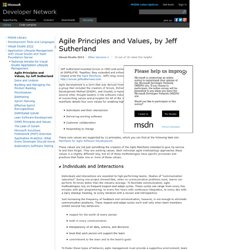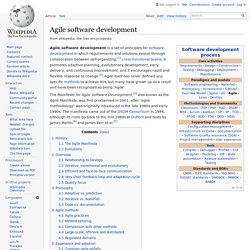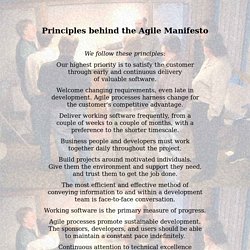

CWE - Common Weakness Enumeration. Home - Web Application Security Consortium. OWASP. Projectmanagement training - Appendix 10: Sample project plan. Agile Software Is A Cop-Out; Here’s What’s Next. Never has a new trend annoyed me as much as Agile.

Right from the get-go, the Agile Manifesto revealed the weaknesses and immaturity of the founding principles. The two most disturbing: “Working software is the primary measure of progress” and “Business people and developers must work together daily throughout the project.” These are cop-outs because: Using “working software as the measure of progress” is narcissistic. Rush to write code is oft the translation of this misguided principle.
Yikes. A New Thesis For A Better Approach To Software DevelopmentFor the future of application development to be insanely great user experiences, we need a new software development methodology. Parallel. The parallel, immersive software studio is different from other methodologies in five important ways: Software is not code. This post about parallel, immersive software studio (STUDIO) can’t compete with the 1,813 books about Agile Software on Amazon.com right now. Recommended reading: Agile Project Management Software, Agile Tools, Scrum Tools, Agile Software, Scrum Software. Scrum Log Jeff Sutherland. Agile Principles and Values, by Jeff Sutherland. Individuals and interactions are essential to high-performing teams.

Studies of "communication saturation" during one project showed that, when no communication problems exist, teams can perform 50 times better than the industry average. To facilitate communication, agile methodologies rely on frequent inspect-and-adapt cycles. These cycles can range from every few minutes with pair programming, to every few hours with continuous integration, to every day with a daily standup meeting, to every iteration with a review and retrospective. Just increasing the frequency of feedback and communication, however, is not enough to eliminate communication problems. These inspect-and-adapt cycles work well only when team members exhibit several key behaviors: respect for the worth of every person truth in every communication transparency of all data, actions, and decisions trust that each person will support the team commitment to the team and to the team’s goals.
Agile software development. Agile software development is a set of principles for software development in which requirements and solutions evolve through collaboration between self-organizing,[1] cross-functional teams.

It promotes adaptive planning, evolutionary development, early delivery, and continuous improvement, and it encourages rapid and flexible response to change.[2] Agile itself has never defined any specific methods to achieve this, but many have grown up as a result and have been recognized as being 'Agile'. The Manifesto for Agile Software Development,[3] also known as the Agile Manifesto, was first proclaimed in 2001, after "agile methodology" was originally introduced in the late 1980s and early 1990s. The manifesto came out of the DSDM Consortium in 1994, although its roots go back to the mid 1980s at DuPont and texts by James Martin[4] and James Kerr et al.[5] History[edit] Incremental software development methods trace back to 1957.[6] In 1974, E.
The Agile Manifesto[edit] Manifesto for Agile Software Development. Principles behind the Agile Manifesto. We follow these principles: Our highest priority is to satisfy the customer through early and continuous delivery of valuable software.

Welcome changing requirements, even late in development. Agile processes harness change for the customer's competitive advantage. Deliver working software frequently, from a couple of weeks to a couple of months, with a preference to the shorter timescale. Business people and developers must work together daily throughout the project.